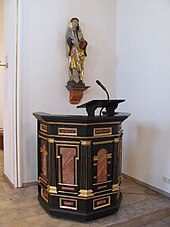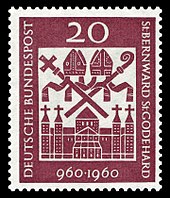Godehard of Hildesheim



St. Godehard or Gotthard von Hildesheim (* 960 in Reichersdorf bei Niederalteich , Lower Bavaria, † May 5, 1038 in Hildesheim ) was Bishop of Hildesheim and one of the most important saints of the Middle Ages. The traces of his veneration (naming churches and places) reach from Italy and Croatia to Scandinavia. With the Gotthard Pass in Switzerland, one of the most important alpine crossings and tunnels bears his name.
Life
According to legendary tradition, Godehard was born in Reichersdorf ( Schwanenkirchen parish , Passau diocese) in 960 . His father Ratmund was appointed provost of the important Benedictine Abbey of Niederaltaich by Archbishop Friedrich von Salzburg . Godehard received his training in the monastery school there . He entered the monastery and, favored by Duke Heinrich (later Emperor Heinrich II.), Became abbot in 996 , first in Niederaltaich, then - simultaneously - in 1001/2 also in Tegernsee and 1005-1012 in Hersfeld ; From 1007 to 1013, the Kremsmünster Abbey was also subordinate to him, which included him in the list of their abbots. At that time, Cluny initiated the great reform movement that Godehard consistently enforced in his monasteries.
After Bernwards death , Godehard was appointed Bishop of Hildesheim by Emperor Heinrich II in 1022 and consecrated by Aribo of Mainz . It was the time of the Saxon emperors when Hildesheim was one of the political and cultural centers of the empire . Godehard energetically continued the building work of his predecessor. Thirty new churches were built in the diocese, the Michaeliskirche was completed in the city, the cathedral received a new westwork . But above all, Godehard deepened the spiritual life of his diocese through trips and synods. His monastic seriousness, but also his serene cheerfulness left a deep impression and are widely praised in the sources. The legends that quickly became associated with his name reflect the power and impact of his personality.
Godehard died on May 5, 1038 in the Mauritian monastery near Hildesheim, which he had founded .
Adoration
The Benedictine monk Hermann der Lahme from Reichenau was the first to report the regional devotion to the Gotthard, which led to the episcopal canonization in connection with the consecration of the renewed cathedral in Hildesheim on May 5, 1061 (until 1170 there were also episcopal canonizations and canonizations in addition to papal canonizations ). Godehard was canonized in 1131 by Pope Innocent II as the first old Bavarian . In Hildesheim, the High Romanesque St. Godehard's Basilica was built in his honor . His relic shrine is venerated in the cathedral crypt. In Niederalteich the Gotthard altar is consecrated to the saint in the parish and abbey church of St. Mauritius. The abbey keeps some of the paraments used by Gotthard: the Gotthard Casel (a gift from Empress Kunigunde, wife of Henry II), a cingulum, a pontifical shoe and his abbot's staff.
With the canonization by the Pope and the Council, the supraregional Gotthard worship and the dissemination of Gotthard relics began. In southern Germany numerous monasteries and altars received Gotthard relics: above all 1135 Zwiefalten , and from there 1141 Huldstetten, 1142 Egelsee , 1156 Münster (Schwäbisch) Hall , 1172 Weißenau and 1179 Salem . The church on Mons Tremulus (Mons Evelinus), consecrated in 1230, became important for further development, and its Gotthard patronage gave the mountain massif and the pass the name Gotthard since 1293 . From there, the rulers of Milan, the Visconti , spread the Gotthard cult in the Milanese territory and in the alpine valleys in Ticino they claimed for essentially political reasons. From northern Italy and the Gotthard Pass, the Gotthard veneration radiated back in a second wave from the end of the 13th century on the Gotthard route, which has since also been passed by wagon for "heavy traffic". South German Gotthard first mentions of this epoch (1335 Eichstätt / Altmühl, 1352 Kuppingen / Herrenberg, 1353 Müllheim / Baden) together with the mention of a Seuridus de Zullhard (Seifried von Zillenhard ) on a pay list of the Visconti establish the spread of Gotthard worship up to Today's district of Göppingen , near St. Gotthardt , the only town with this name north of the Alps and outside of Northern Italy and Austria, within a view of Zillenhart Castle and on an important route between Kirchheim unter Teck and Süßen .
Godehard is the patron saint of the Thuringian city of Gotha , in whose coat of arms the bishop is also depicted. According to legend, in his time as abbot of the Hersfeld monastery (which owned property in and around Gotha) and a. erect the first city wall, lay out gardens and build the city church of St. Margarethen . To this day, the city honors its patron saint with the two-day Gothardus Festival , which takes place annually on the first weekend in May (i.e. around the day of Godehard's death). The traditional Gotthard School in Gotthardstraße was closed in 2003 and only exists by name.
The Abbey Niederaltaich commemorates its important saints, by the monastic school the name " St. Gotthard school bears".
Godehard is usually depicted as a bishop with glowing coals in his coat. The depiction goes back to a legend according to which Godehard is said to have carried the glowing coals for the censer in his robe in his youth as an altar boy without them having burned anything.
The life of Godehard is described in two vitae by the Hildesheim cleric Wolfhere .
Remembrance day
- Catholic: May 5th ( not required day of remembrance in the regional calendar for the German-speaking area ; festival in the diocese of Hildesheim's own calendar ; required day of remembrance in the diocese of Passau; not required day of remembrance in the diocese of Hamburg and the diocese of Fulda )
- Evangelical: May 5th (memorial day in the Evangelical Calendar of Names of the Evangelical Church in Germany )
swell
- Vita Godehardi episcopi Hildenesheimensis auctore Wolfheri . In: Georg Heinrich Pertz u. a. (Ed.): Scriptores (in Folio) 11: Historiae aevi Salici. Hanover 1854, pp. 162-221 ( Monumenta Germaniae Historica , digitized version )
- Translatio Godehardi episcopi Hildesheimensis . In: Georg Heinrich Pertz u. a. (Ed.): Scriptores (in Folio) 12: Historiae aevi Salici. Hannover 1856, pp. 639–652 ( Monumenta Germaniae Historica , digitized version )
literature
- Friedrich Wilhelm Bautz : Godehard of Hildesheim. In: Biographisch-Bibliographisches Kirchenlexikon (BBKL). Volume 2, Bautz, Hamm 1990, ISBN 3-88309-032-8 , Sp. 259-259.
- Wilhelm Berges : Godehard. In: New German Biography (NDB). Volume 6, Duncker & Humblot, Berlin 1964, ISBN 3-428-00187-7 , pp. 495-497 ( digitized version ).
- Stephanie Haarländer : Vitae episcoporum. A genre of sources between hagiography and historiography, examined using biographies of bishops of the Regnum Teutonicum in the age of the Ottonians and Salians. In: Monographs on the history of the Middle Ages 47. Stuttgart 2000
- Josef Fellenberg called Reinold: The worship of Saint Gotthard of Hildesheim in the church and the people. Bonn 1970 (= Rheinisches Archiv Volume 74).
- Max Manitius : History of Latin Literature in the Middle Ages 2nd part. Pp. 313-317
- Sigmund Ritter von Riezler : Gotthard . In: Allgemeine Deutsche Biographie (ADB). Volume 9, Duncker & Humblot, Leipzig 1879, pp. 482-484.
- Georg Stadtmüller , P. Bonifaz Pfister OSB: History of Niederaltaich Abbey . Augsburg 1971.
Web links
- Godehard von Hildesheim in the personal register of the Germania Sacra online
- Opening of the Godehard Shrine (video)
Individual evidence
- ↑ Dieter Mertens : St. Gotthardt - Patron and Patronage - Lecture on December 1st, 1987 for the inauguration of the Evangelical Parish House St. Gotthardt (typescript) - archived in the holdings of the parish, city and district archives
- ^ Andreas M. Cramer: Die Gothaer Sagen , Gotha 2005, p. 11
- ↑ How St. Gothardus got into the city arms on www.echt-gothsch.de
- ^ Godehard von Hildesheim in the ecumenical dictionary of saints
| predecessor | Office | successor |
|---|---|---|
| Bernward |
Bishop of Hildesheim 1022-1038 |
Thietmar |
| Bernhar |
Abbot of Hersfeld 1005-1012 |
Arnold |
| Gozbert |
Abbot of Tegernsee 1001–1002 |
Eberhard I. |
| personal data | |
|---|---|
| SURNAME | Godehard of Hildesheim |
| ALTERNATIVE NAMES | Gotthard of Hildesheim |
| BRIEF DESCRIPTION | Medieval saint, Abbot of Niederalteich and Bishop of Hildesheim |
| DATE OF BIRTH | 960 |
| PLACE OF BIRTH | Reichersdorf near Niederalteich , Lower Bavaria |
| DATE OF DEATH | May 5, 1038 |
| Place of death | Hildesheim |

